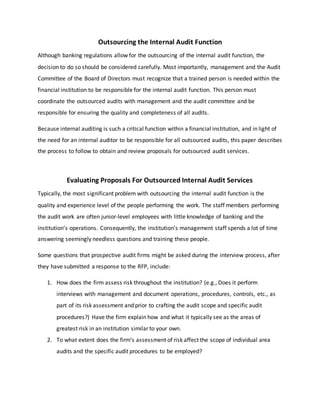
Outsourcing the Internal Audit Function
- 1. Outsourcing the Internal Audit Function Although banking regulations allow for the outsourcing of the internal audit function, the decision to do so should be considered carefully. Most importantly, management and the Audit Committee of the Board of Directors must recognize that a trained person is needed within the financial institution to be responsible for the internal audit function. This person must coordinate the outsourced audits with management and the audit committee and be responsible for ensuring the quality and completeness of all audits. Because internal auditing is such a critical function within a financial institution, and in light of the need for an internal auditor to be responsible for all outsourced audits, this paper describes the process to follow to obtain and review proposals for outsourced audit services. Evaluating Proposals For Outsourced Internal Audit Services Typically, the most significant problem with outsourcing the internal audit function is the quality and experience level of the people performing the work. The staff members performing the audit work are often junior-level employees with little knowledge of banking and the institution’s operations. Consequently, the institution’s management staff spends a lot of time answering seemingly needless questions and training these people. Some questions that prospective audit firms might be asked during the interview process, after they have submitted a response to the RFP, include: 1. How does the firm assess risk throughout the institution? (e.g., Does it perform interviews with management and document operations, procedures, controls, etc., as part of its risk assessment and prior to crafting the audit scope and specific audit procedures?) Have the firm explain how and what it typically see as the areas of greatest risk in an institution similar to your own. 2. To what extent does the firm’s assessment of risk affect the scope of individual area audits and the specific audit procedures to be employed?
- 2. 3. How do the results of their work affect the scope during an audit? For example, if they find problems, do they expand the scope? 4. To what degree do they test compliance with institution policies and banking laws and regulations? It is important that they explain the level of detail of their compliance testing. How do they determine and select the sample size (e.g., judgmental, random, statistical)? 5. To what degree do they provide cost savings or earnings improvement recommendations regarding operations, procedures, and practices of the institution? 6. Who will be assigned to the audit, and what is his or her background and prior financial institution audit experience? This is a crucial issue, because many firms bait-and-switch, with the partner or manager selling the engagement but actually spending relatively little time at the institution. Instead, junior employees with little experience perform the bulk of the work. Don’t accept recent college graduates working on their CPAs, no matter how experienced the management team is. 7. How do they coordinate their work at the institution, with whom, and how often? Do they utilize financial institution resources to complete audit work (e.g., prepare schedules)? To what extent is this done? How do they verify the quality of this work? 8. Based on the data processing arrangements at the institution (i.e., outsourced versus in- house), how will the firm approach auditing data processing? What types of testing of systems, applications, controls, and procedures will they perform? 9. How will they present their work or results? How often? To whom? 10. How often will they meet with the Board and/or Audit Committee? 11. Will their documentation be available for inspection by the financial institution? Not just the reports, but the audit programs, schedules, test work, memoranda, etc.? If not, why? Challenge the argument that “It’s our property.” How else will management and the directors be able to evaluate the completeness and effectiveness of the firm’s work if they cannot see the work? 12. Who owns the “product” (i.e., questionnaires, audit programs, permanent work paper files, etc.) and where the I/A files will be, including audit programs, audit work papers,
- 3. etc. The institution may want to bring the audit function in-house in the future, and this information will have value in that case.